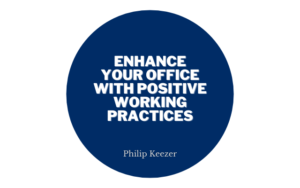The positive working practice is not a common term you hear thrown around business conferences or corporate training. It’s not a term we widely use. But it’s an important principle to keep in mind if you want to take your office culture to the next level.
If you ever wondered how to improve your office environment, this article is for you. I’ll delve into positive working practices, explain what they are, and how you can apply them to your everyday tasks as a manager.
What Are Positive Working Practices?
Positive working practice is a term widely used in the health and social working sector. Interestingly enough, after reading scientific papers and watching a lot of presentations on the topic, I still couldn’t find a clear definition for the term.
Most of the content on this topic is centered around the benefits of positive working practices. So I’ll attempt to share my definition of the term. In my view, positive working practices can be understood as any communication and work that reinforces the self-esteem and happiness of your coworkers.
So think about offering positive feedback, encouraging your employees through a crisis, and rewarding good work. But it’s not easy, and it takes focus and dedication to be able to reinforce the good behaviours of your employees, as well as grow their confidence in what they’re doing.
But it’s worth it.
What Are The Benefits Of Positive Working Practice?
Positive working practices can help you enhance your office in a myriad of ways. For one, if you focus on reinforcing positive thinking, boosting the confidence of your employees, and creating a happy working environment, your employees will be happier to show up to work. In and of itself, that’s a win you shouldn’t overlook.
Even if just because it’s a better place for you as well.
But the benefits go way deeper.
For example, happier employees stay longer with your company. Employee retention is extremely important, especially now that the gates of remote work and freelancing have been opened by the CoVid pandemic. Retaining talent is extremely tough, especially if you’re a startup and can’t compete with big corporations in terms of attractive packages.
But it also means you’ll spend less money in the long run. Hiring new people is time and money consuming, so sticking on to your team members is fruitful.
But it’s not like you just keep random people employed. Happier employees output better work too. And the reason for that is twofold. First, because they stay in your company longer, so they have the time to get better at their job, develop their own procedures, and learn new skills. Second, because reinforcing their quality work makes them more confident, and so they take more responsibility for their actions.
Lastly, positive working practices also work extremely well with a coaching management style. If that sounds new to you, make sure you read our article about how to find your management style.
So these are the benefits.
But how do you go about applying positive working practices in your office?
How To Apply Positive Working Practices
Positive working practices have a lot to do with your mindset and attitude whenever you’re interacting with your employees. You should always be focused on the full side of the glass, looking for the positive thing to say or do.
Note here that this generally falls into the affiliative management style, which is not necessarily the right pick at all times. You should find a balance between all management styles, and this article will help you with that.
But if there is no pressing situation or particular team requirement, you can default to positive working practices. Here’s what to do in particular.
Boost The Confidence Of Your Employees
Whenever someone does a good job, you should let them know. Impostor syndrome is very real for most people in the workforce today, so it’s important that you help your team get over it and perform at their peak.
A good client onboarding, a big sale, a bug your team worked around – all of these, and many more, should be reasons for you to congratulate your team and reinforce their confidence in what they can do.
It’s an important step in positive working practices. But people sometimes mess up. What do you do then?
Use The Sandwich Feedback Method
People make mistakes. It’s normal for your employees to do too, regardless of how good they are. But the way you react is extremely important if you want to reinforce a positive working environment.
The sandwich feedback method is simple – Whenever you want to offer feedback on something, start with a positive thing about what your employee did, then mention something you’d like they improved, then round it up with another positive thing.
For example, let’s say one of your sales agents signed up a new client, but they offered a discount that was not protocol, thus decreasing your profit margin on that client. You can offer feedback on their work by saying something like:
“Congrats on signing that client! I think it’s great that our customer base is constantly expanding, and your work definitely helped us reach our quarterly goals. I do think it’s important to stick to procedure, so you might want to read up on our standard discounts and offers, just to make sure that we can stay afloat. But good job on the swiftness with which you closed the deal!”
Sure, the way this point gets across depends a lot on how your tone and attitude is throughout the talk. But this can go a long way in helping your employees build confidence in their work, as well as polish their rough corners.
Be Authentic With Your Employees
Most people aren’t naive, and they can see through fake compliments or “niceties” for the sake of being positive. You want to avoid that, and you should never force yourself to say something just to try to be positive.
Instead, be authentic.
Compliment something when you truly appreciate it. Express yourself authentically, and you’ll be able to create a positive working environment, which will first of all benefit yourself, and your company as well.
In Conclusion
Positive working practices aren’t a staple of modern working environments. They’re something used by health and social workers to ease the pain of people in a rough situation.
But that doesn’t mean they’re not fit for a modern office. They can have real benefits, and I hope that today you were able to learn how to enhance your office through positive working practices.
What do you think? Will you use anything you learned today?














